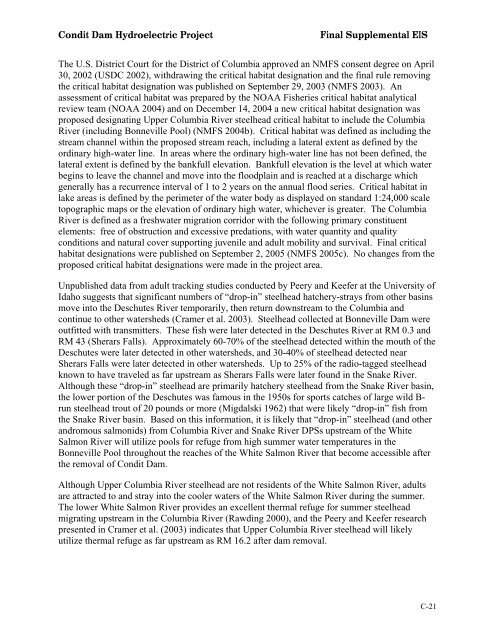Condit Dam Removal Condit Dam Removal - Access Washington
Condit Dam Removal Condit Dam Removal - Access Washington
Condit Dam Removal Condit Dam Removal - Access Washington
You also want an ePaper? Increase the reach of your titles
YUMPU automatically turns print PDFs into web optimized ePapers that Google loves.
<strong>Condit</strong> <strong>Dam</strong> Hydroelectric Project<br />
Final Supplemental EIS<br />
The U.S. District Court for the District of Columbia approved an NMFS consent degree on April<br />
30, 2002 (USDC 2002), withdrawing the critical habitat designation and the final rule removing<br />
the critical habitat designation was published on September 29, 2003 (NMFS 2003). An<br />
assessment of critical habitat was prepared by the NOAA Fisheries critical habitat analytical<br />
review team (NOAA 2004) and on December 14, 2004 a new critical habitat designation was<br />
proposed designating Upper Columbia River steelhead critical habitat to include the Columbia<br />
River (including Bonneville Pool) (NMFS 2004b). Critical habitat was defined as including the<br />
stream channel within the proposed stream reach, including a lateral extent as defined by the<br />
ordinary high-water line. In areas where the ordinary high-water line has not been defined, the<br />
lateral extent is defined by the bankfull elevation. Bankfull elevation is the level at which water<br />
begins to leave the channel and move into the floodplain and is reached at a discharge which<br />
generally has a recurrence interval of 1 to 2 years on the annual flood series. Critical habitat in<br />
lake areas is defined by the perimeter of the water body as displayed on standard 1:24,000 scale<br />
topographic maps or the elevation of ordinary high water, whichever is greater. The Columbia<br />
River is defined as a freshwater migration corridor with the following primary constituent<br />
elements: free of obstruction and excessive predations, with water quantity and quality<br />
conditions and natural cover supporting juvenile and adult mobility and survival. Final critical<br />
habitat designations were published on September 2, 2005 (NMFS 2005c). No changes from the<br />
proposed critical habitat designations were made in the project area.<br />
Unpublished data from adult tracking studies conducted by Peery and Keefer at the University of<br />
Idaho suggests that significant numbers of “drop-in” steelhead hatchery-strays from other basins<br />
move into the Deschutes River temporarily, then return downstream to the Columbia and<br />
continue to other watersheds (Cramer et al. 2003). Steelhead collected at Bonneville <strong>Dam</strong> were<br />
outfitted with transmitters. These fish were later detected in the Deschutes River at RM 0.3 and<br />
RM 43 (Sherars Falls). Approximately 60-70% of the steelhead detected within the mouth of the<br />
Deschutes were later detected in other watersheds, and 30-40% of steelhead detected near<br />
Sherars Falls were later detected in other watersheds. Up to 25% of the radio-tagged steelhead<br />
known to have traveled as far upstream as Sherars Falls were later found in the Snake River.<br />
Although these “drop-in” steelhead are primarily hatchery steelhead from the Snake River basin,<br />
the lower portion of the Deschutes was famous in the 1950s for sports catches of large wild B-<br />
run steelhead trout of 20 pounds or more (Migdalski 1962) that were likely “drop-in” fish from<br />
the Snake River basin. Based on this information, it is likely that “drop-in” steelhead (and other<br />
andromous salmonids) from Columbia River and Snake River DPSs upstream of the White<br />
Salmon River will utilize pools for refuge from high summer water temperatures in the<br />
Bonneville Pool throughout the reaches of the White Salmon River that become accessible after<br />
the removal of <strong>Condit</strong> <strong>Dam</strong>.<br />
Although Upper Columbia River steelhead are not residents of the White Salmon River, adults<br />
are attracted to and stray into the cooler waters of the White Salmon River during the summer.<br />
The lower White Salmon River provides an excellent thermal refuge for summer steelhead<br />
migrating upstream in the Columbia River (Rawding 2000), and the Peery and Keefer research<br />
presented in Cramer et al. (2003) indicates that Upper Columbia River steelhead will likely<br />
utilize thermal refuge as far upstream as RM 16.2 after dam removal.<br />
C-21




